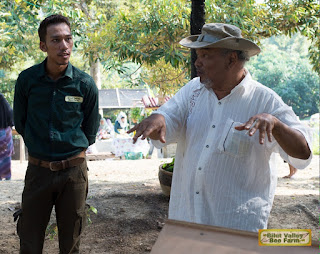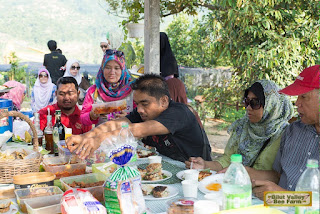The stingless bees fraternity in Malaysia is rapidly growing as more people are aware of the benefits of the honey and how relatively easy it is to culture them compared to the common honey bees. While it is heartening to know that there is more pure, local honey made available by the increase in bee farmers, it raises the issue of how well-informed they are in ensuring the bees are properly cultured and that there is sustainability in the long term. There are also concerns that trees are logged in large numbers to get the stingless bee colonies by irresponsible, greedy and unscrupulous traders.

With this grave concern in mind, Tuan Abu Hassan Jalil or
Pak Abu as he is known to most, had taken the initiative to make visits to bee farms and even those who rear meliponines on a small scale to share, educate and provide as much knowledge on Good Bee Practices. With a group of enthusiasts comprising mainly participants in the workshops he conducts, Pak Abu started with a roadshow to the Northern region of the peninsula in March this year followed by the Southern region in early May.

Come June, it was the turn of the East Coast region and Bilut Valley Bee Farm was scheduled to be the first stop on this itenerary. We played host to the convoy from the
Le Tour de Kelulut, Jelajah Pantai Timur on Saturday 6th of June, 2015 and they were expected to arrive at 9a.m.
We were very fortunate because this tour was joined by Prof. Dr. Hajah Siti Salmah Idrus from University Andalas in Padang, Indonesia. She was accompanied by her husband Dr. Idrus and their grand-daughter Anggi. Prof. Siti Salmah had done extensive research on meliponines and had worked with renowned researchers in a similar field. A sprightly 80-year, she had completed the whole tour which took four days, and in each of the four days, the tour ended late at night.
Among the objectives of the Road Tours are:
- To meet with meliponiculturists and enthusiasts to discuss current issues.
- To compile current meliponiculture techniques to derive an SOP.
- To compile a list of FAQs.
- To propose a petition for the formation of a Bee Council to set standards of meliponine based products, it's certification and enforcement.
- To provide consultancy services where necessary
- To collect honey sampling for lab tests by representatives of UiTM Puncak Alam and UMT researchers and students.
- To collect honey samples for Ranking of Honey packages based on colour, taste, labels and guided by lab test reults
- To collect specimens to study variation in species especially from the genus Tetragonula.
 |
Pak Abu giving tips and advice on meliponiculture and Good Bee Practices. His love and passion for meliponines is his only reason for doing this. And that says a lot about his commitment towards the conservation of what is to him, a national treasure.
In the background in red cap is Hj Zolkaplie Mustafa, one of the 8000 aborists in the world. |
 |
| Pak Abu with the COO of BVBF listening intently to what the expert has to say |
 |
| Pak Abu with a species he named Marziacea sweetinea |
 |
| A very good experience from the tour, we get to see actual conditions on each others' farms and we are able to discuss a problem and provide a solution if necessary. Seen here are standing, Ariff Amri, sitting right, Hj, Najib and Zaki on the left. Along with a few others under the tutelage of Pak Abu, they share their knowledge and experience so generously. A great show of camaraderie brought about by a mutual love for meliponines. |
 |
| Our neighbour and fellow meliponiculturist from Raub, Azrul with his father |
 |
| We served freshly made grilled chicken sandwiches and salad with dressings that contained meliponine honey |
 |
| From left, Pak Abu, Wak Abdul Aziz, Prof. Siti, Dr. Idrus and Anggi |
 |
| Ariff Amri owner of Humaira Honey |
 |
| Nur Raziana and her husband Wan. Nana is an orang asli from the Mah Meri tribe. She is one of the most hardworking, resourceful and proactive woman we've seen. |
 |
| This is lovely photo of our garden on the farm by Nana |
 |
| Aiman showing off the topping he had made using a design suggested by Pak Abu. The joints of the topping are overlapping so they are more secure for the meliponines against predators. When conditions in the topping are conducive, they will quickly work upwards to make honey pots |
 |
| Mmm...delicously marinated with honey and grilled by our chef Hadi |
 |
| Zaki from Meru, Klang |
 |
| Hj Najib with his cutie daughter Raisya |
 |
| From left, Datin Aimi, a partner of BVBF, Aniza and Prof Siti Salmah |
 |
| Wak Abdul Aziz, Pak Abu's right wing man |
 |
| Fuad without his wife Zurita |
 |
| Jalur Gemilang on the farm |
 |
| Pak Abu inspecting the hives. He is probably the only expert in beescape in the country and his greatest concern is that this aspect in meliponiculture is not looked into seriously enough. |
 |
| Aniza explaining how honey is made, stored and taken from the involucrum or propolis structure in the topping |
 |
| Thank you to Pak Abu and everyone for visiting our farm. Hope to see the rest of you very soon! |


















































